January 2025
The global active pharmaceutical ingredients market size is calculated at USD 238.38 billion in 2025 and is forecasted to reach around USD 405.09 billion by 2034, accelerating at a CAGR of 6% from 2025 to 2034. The North America market size surpassed USD 86.73 billion in 2024 and is expanding at a CAGR of 6.08% during the forecast period. The market sizing and forecasts are revenue-based (USD Million/Billion), with 2024 as the base year.
The global active pharmaceutical ingredients market size accounted for USD 226.14 billion in 2024 and is predicted to increase from USD 238.38 billion in 2025 to approximately USD 405.09 billion by 2034, expanding at a CAGR of 6% from 2025 to 2034. The active pharmaceutical ingredients market is driven by an influence of precision medicine, an increasing Instances of cardiovascular diseases, high Instances of diabetes, and rising cases of strokes.
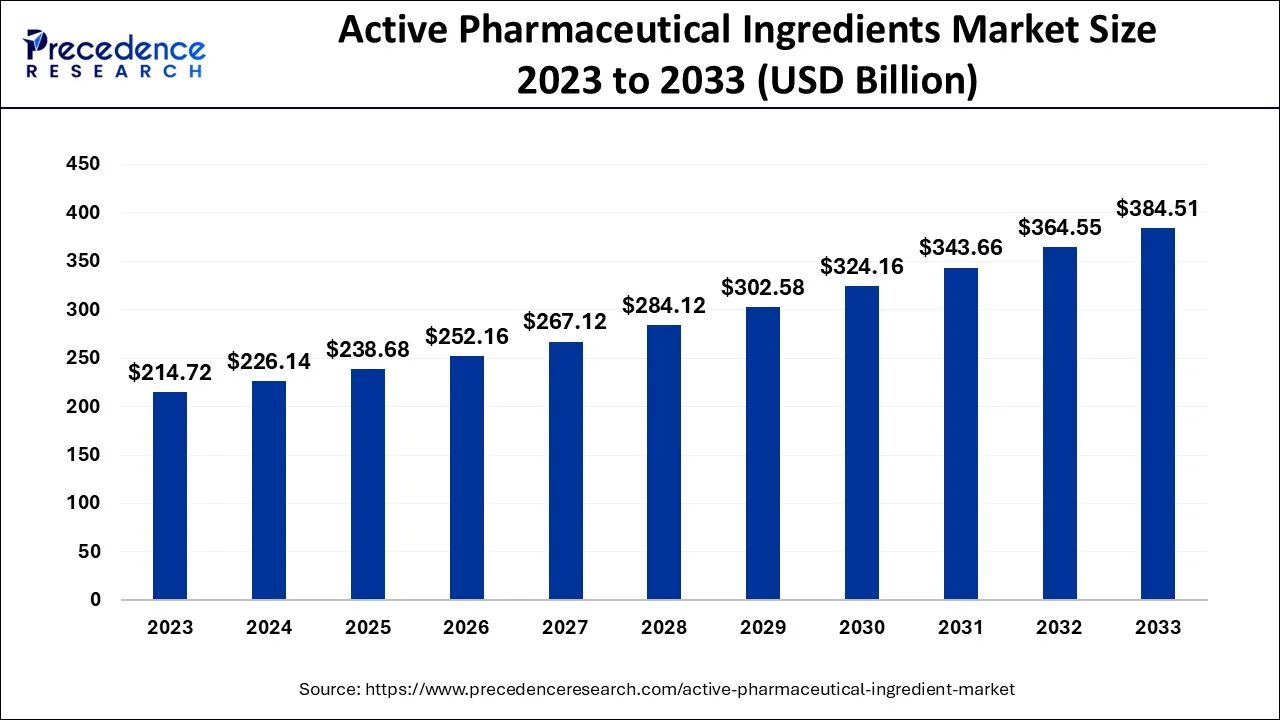
The active pharmaceutical ingredients market significantly benefits from artificial intelligence (AI) integration, driving innovation and efficiency. AI technologies enhance various aspects of the API lifecycle, from discovery to manufacturing and quality control. As the pharmaceutical industry continues to evolve, embracing AI in API manufacturing offers unprecedented opportunities. Manufacturers leverage AI's capabilities to create new and innovative drugs. There are multiple reasons API manufacturers are adopting artificial intelligence in their production processes. The major benefits of using AI in API manufacturing include reduced costs, improved efficiency and quality, increased throughput, and improved product stability.
The U.S. active pharmaceutical ingredients market size was valued at USD 39.28 billion in 2024 and is predicted to be worth around USD 75.6 billion by 2034, at a CAGR of 6.76% from 2024 to 2035.
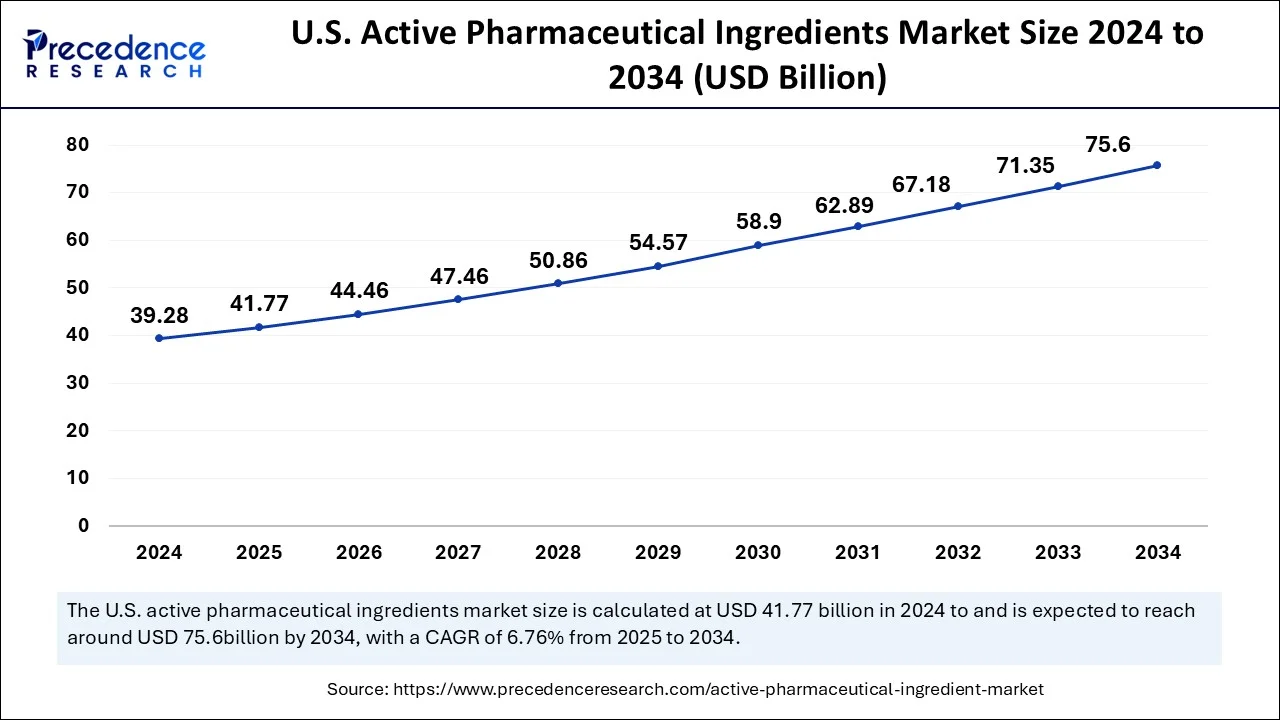
Geographically, North America dominated the global API market closely trailed by Europe. The foremost influences motivating the whole growth of the market in this are budding incidence of chronic diseases, cumulative government emphasis on generic drugs, intensifying demand for specialty drugs and biologics, and technological progressions in the manufacturing processes of APIs. Asia Pacific is expected to record fastest growth in the market throughout the estimate period. This growth is attributed to efforts of foremost corporations in the market for setting up API business plants in emerging nations such as India and China.
North America held largest share in the global active pharmaceutical ingredient (API) market. The U.S. held largest share followed by Canada and Mexico. The development in the active pharmaceutical ingredient (API) market is attributable to the rising expenditure on healthcare across the region. The rising prevalence of chronic diseases along with increasing government initiatives supports the creation of novel medicines and is also expected to accelerate the development of active pharmaceutical ingredients in North America.
The growing demand for biologic active pharmaceutical ingredients (API) in the region due to the patients' quick adoption of biologic medications for the treatment of various chronic illnesses is also driving the regional growth of the market. For instance, the Alzheimer's Association estimates that 6.2 million Americans over the age of 65 already have Alzheimer's disease, and the count will rise to 12.7 million by the year 2050. This boosts the demand for donepezil, a synthetic active pharmaceutical ingredient that can be utilized in pharmaceutical preparation for treating Alzheimer’s disease. As a result, the prevalence of this chronic disease issue has augmented the growth of this market in the North American continent. The rising obesity rates across the U.S. are creating major market opportunities for the growth of the market. As per the 2021 National Health Statistics Report, the prevalence of obesity was 19.7% between 2017 to March 2020 among children and adolescents aged 2–19 years. The age-adjusted prevalence of obesity was 41.9% among adults aged 20 and over, severe obesity was 9.2%, and diabetes was 14.8%. Among adults aged 18 and over, the age-adjusted prevalence of hypertension was 45.1%. This has resulted in an increase in demand for active pharmaceutical ingredients which in turn has resulted in the growth of the active pharmaceutical ingredient (API) market in the region.
The active pharmaceutical ingredient (API) market in Canada is expected to grow owing to the presence of companies that are involved in the development and manufacturing of inventive medicines and generic medications, as well as over-the-counter drugs. Additionally, an increase in the prevalence of chronic diseases among Canadians and the comorbidities linked to the illnesses are projected to have a beneficial effect on the expansion of the active pharmaceutical ingredient (API) market during the forecast period. For instance, according to the Public Health Agency of Canada analysis, among the top chronic diseases and conditions most prevalent among Canadians are hypertension, ischemic heart diseases (IHD), osteoporosis, asthma, diabetes, chronic obstructive pulmonary diseases, and cancer. This will increase the demand for pharmaceutical products and is further likely to support the growth of the active pharmaceutical ingredient (API) market.
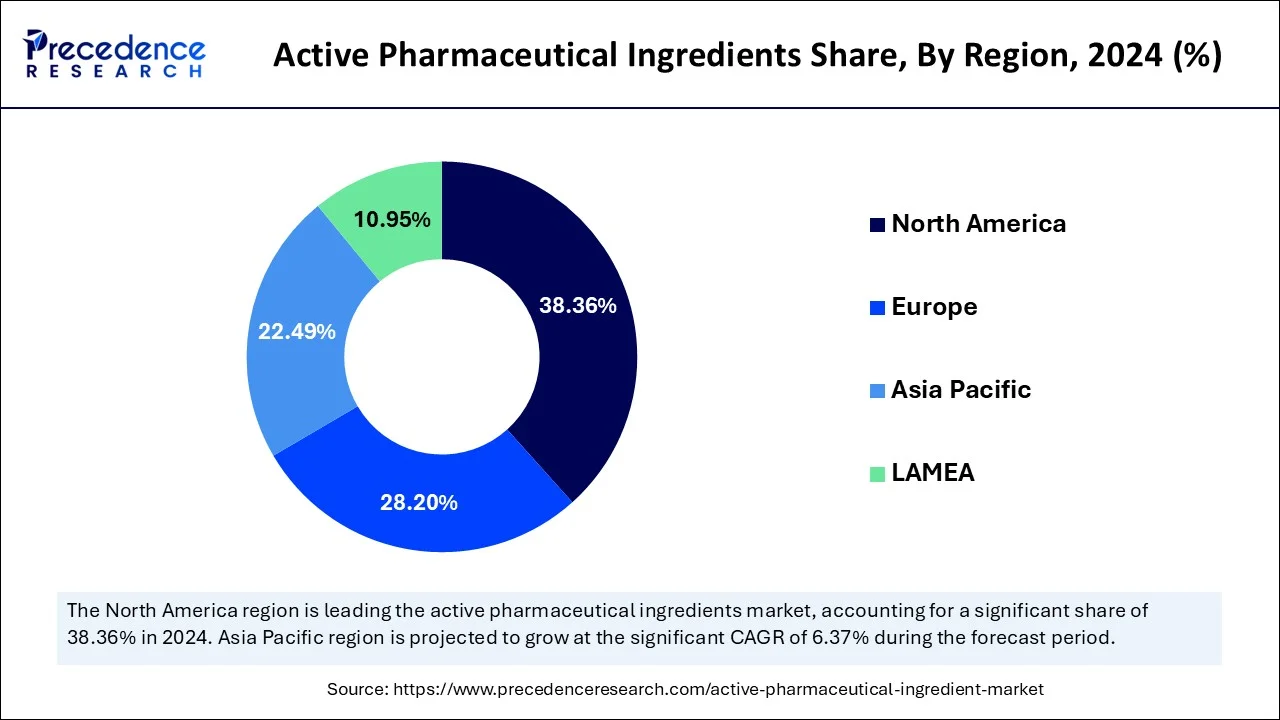
Asia Pacific is projected to grow at the fastest with a CAGR of 6.3% during the forecast period. China dominated the Asia Pacific region, followed by India and Japan. The China active pharmaceutical ingredients market has been calculated at USD 14.48 billion in 2025. The pharmaceutical and contract manufacturing industries are expanding in various countries, including China and India, and this is projected to fuel the growth in the Asia Pacific market. Due to factors such as accessibility of production- ready raw materials and cheaper labour costs, these countries are emerging as desirable locations to outsource the manufacturing of active pharmaceutical ingredients as well. Additionally, the region's favourable regulatory framework is enticing many manufacturers to increase their production capacity which is expected to fuel the market's growth in the region. Further, organizations are undergoing digital transformation through Manufacturing 4.0 with capabilities to ensure good manufacturing practice (GMP) compliance. Additionally, the rising life expectancy along with lifestyle and dietary changes contribute to more non-communicable diseases and are expected to increase in demand for pharmaceutical drugs and hence active pharmaceutical ingredients in the region.
Also, the Made in China 2025 initiative emphasizes on the biotechnology and pharmaceutical sectors to help China become a high value-add economy. China has completely redesigned its healthcare system with the Volume-based Procurement (VBP) policy and National Reimbursement Drug List (NRDL). The major objective is to give consumers more widespread access to high-quality medications at less cost. The need for higher-quality medications will also increase with rising consumer wealth in the future years. The government places more emphasis on the increased production of copyrighted medicines and increased innovation. The above- mentioned factors are expected to fuel the active pharmaceutical ingredient demand across the economy.
The Indian active pharmaceutical ingredient (API) market is expected to grow owing to a surge in generic drug exports. India emerged as one of the most attractive locations not only for investments but also for doing business. India jumped 79 positions from 142nd in 2014 to 63rd in 2019 in the ‘World Bank's Ease of Doing Business Ranking 2020’. India is one of the largest providers of generic drugs. The increasing percentage of heart disease and the growing pharmaceutical industry are anticipated to drive industry growth and competitiveness in the country. Further, the pandemic spurred Indian drug producers to significantly increase their R&D expenditure. In order to reduce their reliance on Chinese deliveries, Indian drug producers worked towards increasing the local production of Active Pharmaceutical Ingredients (APIs). These factors are likely to augment the growth of the active pharmaceutical ingredient (API) market.
The active elements in a pharmaceutical medicine that have the desired impact on the body to treat a condition are known as active pharmaceutical ingredients (APIs). Chemical substances are processed to create APIs. The active component of a biologic medication is referred to as a bulk process intermediate. Due to the rising incidence of chronic diseases including diabetes, asthma, and cancer, the API market has seen some appealing potential despite high manufacturing costs, rigorous regulatory laws, and policies in many countries restricting medicine prices.
| Report Coverage | Details |
| Growth Rate from 2025 to 2034 | CAGR of 6% |
| Market Size in 2024 | USD 226.14 Billion |
| Market Size in 2025 | USD 238.68 Billion |
| Market Size by 2034 | USD 405.09 Billion |
| Dominant Region | North America |
| Fastest Growing Region | Asia Pacific |
| Base Year | 2024 |
| Forecast Period | 2025 to 2034 |
| Segments Covered | Type of Synthesis, Type of Manufacturer, Application, Type and Region |
| Regions Covered | North America, Europe, Asia-Pacific, Latin America, and Middle East & Africa |
Rising requirement for personalized medicine
Personalized medicine requires the development and production of customized drugs tailored to the specific needs of individual patients. Active pharmaceutical ingredients are the essential components of pharmaceutical drugs and are responsible for their therapeutic effects. As personalized medicine requires specific drug formulations, there is an increasing need for customized active pharmaceutical ingredients to match the unique requirements of patients. Personalized medicine relies heavily on genetic testing and biomarkers to identify the most effective treatment options for individual patients. As the use of genetic testing becomes more widespread, there is an increased need for active pharmaceutical ingredients to develop and produce drugs that can be matched to patients based on their genetic profiles.
Complicated production methodology
Many active pharmaceutical ingredients have complex molecular structures, requiring multi-step synthesis routes. Each step must be carefully optimized and validated, which can be time-consuming. The availability and sourcing of raw materials can also affect production timelines, especially if there are supply chain disruptions or quality issues with raw materials. Consistency in active pharmaceutical ingredients production is crucial to ensure uniform drug efficacy and safety. Extensive testing and adjustments between batches can slow down production. The active pharmaceutical ingredients manufacturing industry may face limitations in production capacities, resulting in longer lead times for meeting market demand.
Rising requirements for oncology therapies
Pharmaceutical companies and research institutions continually strive to develop new and more effective oncology treatments. These efforts lead to the discovery of potential active pharmaceutical ingredients candidates, providing active pharmaceutical ingredients manufacturers with opportunities to collaborate and supply active pharmaceutical ingredients for clinical trials and drug development. Many blockbuster oncology drugs are coming off-patent, leading to the rise of generic versions. Generic drug manufacturers need active pharmaceutical ingredients to produce these generic oncology drugs at a lower cost. This presents a significant opportunity for active pharmaceutical ingredients suppliers to cater to the growing demand for generic oncology drugs. As the complexity of oncology therapies rises, pharmaceutical companies often outsource the manufacturing of active pharmaceutical ingredients to specialized Contract Manufacturing Organizations (CMOs). CMOs can leverage their expertise in API synthesis to serve multiple pharmaceutical companies, leading to an increased demand for active pharmaceutical ingredients in the market.
Quality concerns and contamination issues
The primary concern in pharmaceutical manufacturing is patient safety. Contaminated or impure active pharmaceutical ingredients can lead to adverse reactions, reduced efficacy, or even severe health risks for patients consuming the medications. Ensuring the highest quality standards are met is crucial to avoid such risks. Detecting trace amounts of contaminants in active pharmaceutical ingredients can be difficult using conventional analytical methods. The development and validation of sensitive and specific testing techniques to identify impurities is a constant challenge. Active pharmaceutical ingredients production often involves multiple manufacturers, suppliers, and distributors located in different countries. Coordinating quality control measures across the entire supply chain can be difficult, and the risk of contamination or quality issues increases as the product passes through multiple hands. Thus, the quality concerns and contamination issues create a challenge for the market.
The global active pharmaceutical ingredient market has been classified depending on type of synthesis into synthetic and biotech. Biotechnology has further been categorized into vaccines, recombinant proteins, and monoclonal antibodies.
In 2024, synthetic segment conquered the global API market due to the stress-freeobtainability of raw materials and easier processes for the synthesis of APIs. Growth of biotech segment is recognized due to technological innovations in the manufacturing method and a high level of competence of these molecules. The growing demand for generic drugs is one of the key factors driving the segmental growth of the market. Companies that manufacture synthetic APIs see significant revenue from APIs for generic drugs. Wide-ranging opportunities are now being created for CDMOs operating in the segment. With corporations looking to maximise profitability by lowering production costs, the opportunity in the market for synthetic APIs for CDMOs has grown even more profitable. The market's growth is also related to the low cost of manufacturing associated with small molecules and their great effectiveness. Around 78% of all APIs, which make up the vast majority of the drugs, are small molecules. This increases the demand for finished products and API formulation, which fuels the growth of the synthetic API segment.
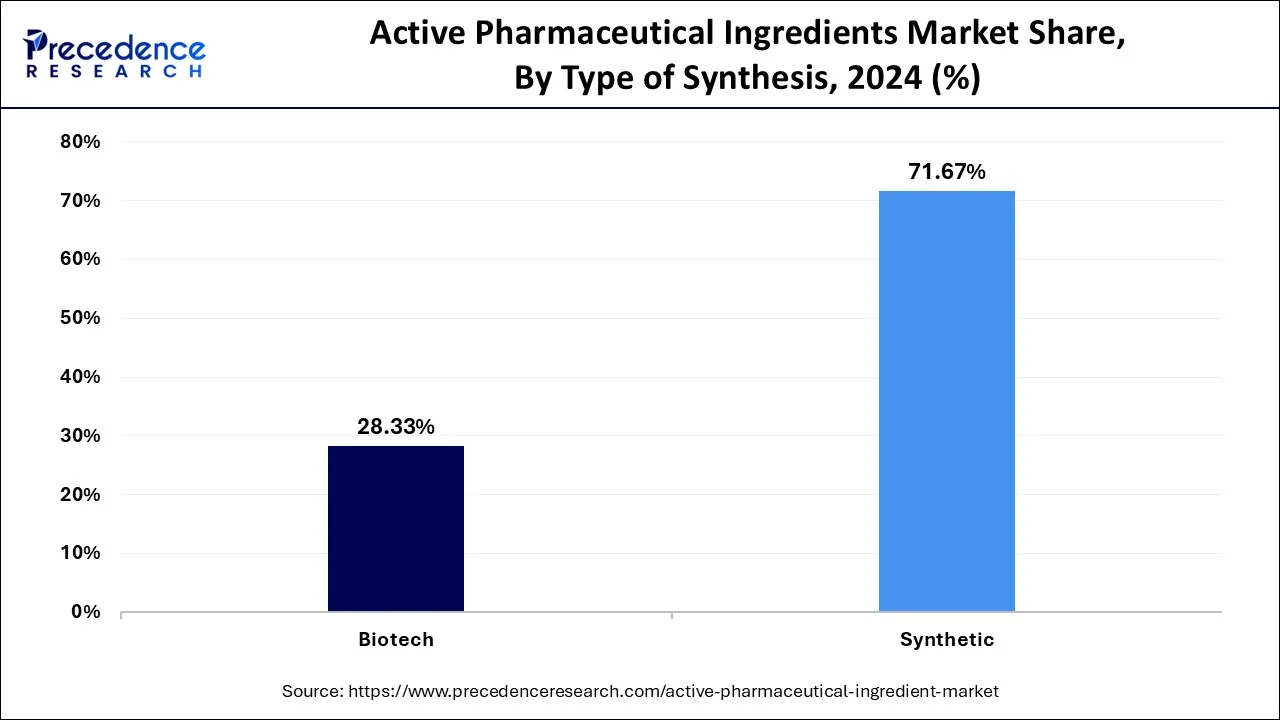
Further, the growth of the biotech segment is anticipated to augment due to the rising demand for biopharmaceuticals and their capacity to treat diseases that were previously incurable. Five medications, including galantamine, rivastigmine, donepezil, memantine, and memantine in combination with donepezil (Namzaric), have been approved by the FDA for the treatment of Alzheimer's disease, as per the Alzheimer's Association 2021 report. Additionally, it also anticipated that by the year 2050, 13.5 million Americans aged 65 and older will be living with Alzheimer's disease, up from an estimated 6.2 million in 2021. In the upcoming years, it is expected that the patient population's demand for biotech APIs would increase as a result of the increasing prevalence of these diseases.
Active Pharmaceutical Ingredient (API) Market Revenue, By Type of Synthesis, 2022-2024 (USD Billion)
| Type of Synthesis | 2022 | 2023 | 2024 |
| Biotech | 57.56 | 60.70 | 64.06 |
| Synthesis | 146.48 | 154.02 | 162.08 |
The innovative APIs lead the global market on account of the existence of promising government guidelines, recognized R&D facilities, and augmented subsidies for innovative drug development. Due to widespread research in this field, numerous novel groundbreaking products are in the pipeline and are estimated to be introduced in years to come. Ongoing research and development in the field of innovative APIs are exhibiting a large number of innovative products in the pipeline that is expected to be marketed in the upcoming years. For instance, Glenmark is currently engaged in R&D with a new molecule named Ryaltris- GSP 301 intended for the treatment of allergic Rhinitis. Satisfactory regulatory guidelines for R&D innovation centers as well as increased expenditure are propelling the growth of the innovative APIs segment. The introduction of emerging market players and increasing regulatory agency support for new medication clearance is expected to aid market expansion, which may be due to the government's increased attention on healthcare and pharmaceuticals as a result of COVID-19.
In addition to this, the extensive need for targeted treatments including high-potency API molecules, such as HPAPI, is expected to drive even more demand for customized medications. Such innovations in the development of pharmaceutical drugs are expanding the growth of innovative APIs. Furthermore, because of the requirement for low doses and fewer side effects, oncology is a major domain for high-potency novel API medicines. As a result, the majority of HPAPIs are found in anticancer medications. These APIs have also been utilized to treat hormonal imbalances, musculoskeletal, cardiovascular, and CNS medications, as well as glaucoma.
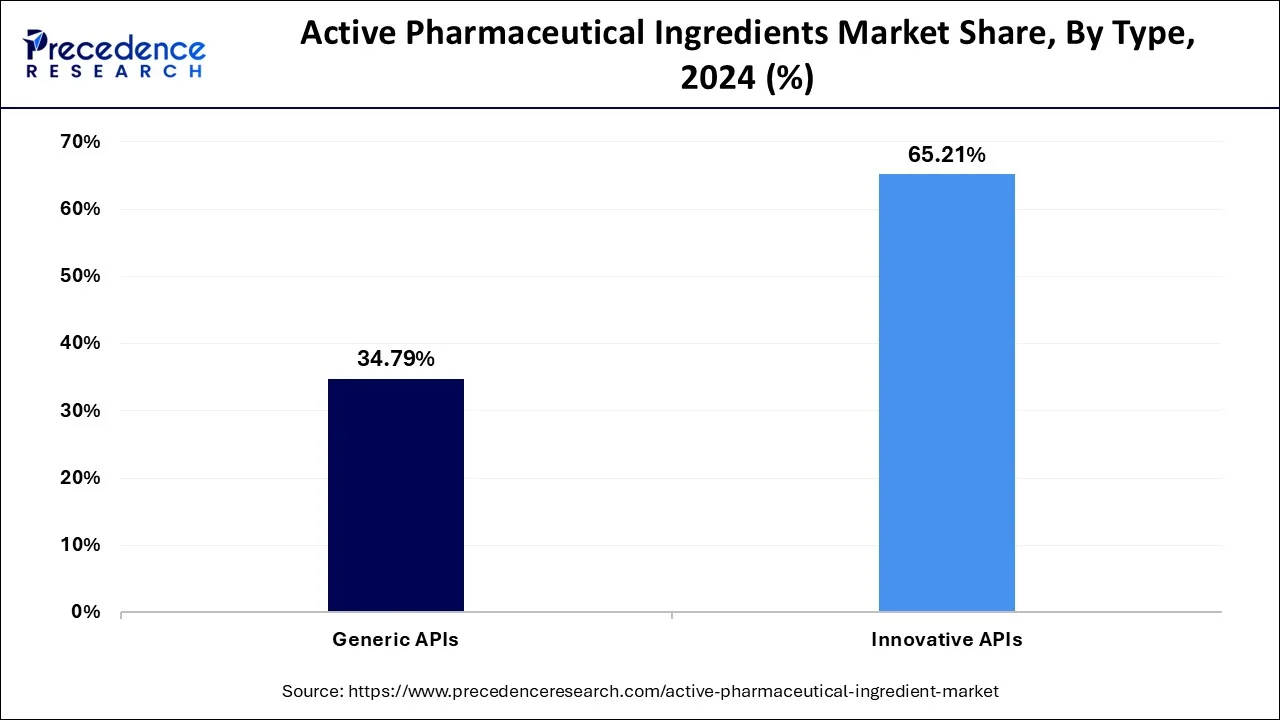
Generic APIs are the same chemical substances used in drugs that were formerly covered by chemical patents. Generic APIs can be sold in the market only after the expiration of patented original drugs. The active pharmaceutical ingredient (API) in a generic medicine is identical to the original drug, but there are modifications in other aspects such as manufacturing method, formulation, taste, colour, excipients, and packaging. According to FDA, generic APIs are generic drugs that must be similarly effective as their branded medicines and hence they must be possessing similar risks and benefits associated with them.
The percentage of prescriptions for generic pharmaceuticals has increased as a result of the rising approval rates by Abbreviated New Drug Applications (ANDA). This is attributable to the introduction of generic players across therapies and the loss of exclusivity for patented drugs over the past 10 years. Additionally, rising demand for injectable generics is anticipated to promote market segment growth. Owing to the benefits that generic injectable provide in terms of quality, dosage, strength, and a more affordable R&D cycle, governments are funding their production. Other reasons influencing the market's growth include the increasing frequency of drug shortages, particularly in the US, an ageing population, and an increase in chronic and lifestyle disorders. The number of generic drug launches is also increasing. For instance, in March 2022, Natco Pharma in collaboration with Arrow International announced the launch of the first generic version of Celgene's Revlimid drug which is a top selling cancer drug in the US market.
Rising technological advancements in API manufacturing and rising awareness about the importance of generic APIs are some of the factors augmenting the growth of the generic API segment. Low costs associated with generic APIs along with the same quality and same way of consumption is some of the prominent factors propelling the growth of the generic API segment.
Global Active Pharmaceutical Ingredient (API) Market Revenue, By Type, 2022-2024 (USD Billion)
| Type | 2022 | 2023 | 2023 |
| Generic APIs | 70.60 | 74.50 | 78.69 |
| Innovative APIs | 133.44 | 140.22 | 147.45 |
Among different types of manufacturers involved in the API market, Captive API occupied majority of the revenue shares because of stress-free obtainability of raw materials and thorough capitalization of foremost key companies for the progress of high-end manufacturing facilities. Merchant API is projected to be the fastest-growing sector during years to come. The segment development is compelled by influences like high cost of in-house engineering of these molecules and increasing demand for biopharmaceuticals.
CAPTIVE APIS
The in-house manufacturing of the API molecules by some of the pharmaceutical companies is referred to as captive APls. Due to the simple accessibility of raw materials and large expenditures made by key players to establish high-end manufacturing facilities, the captive APIs segment is predicted to grow significantly in the next years. Further evidence that key firms are more focused on internal production than outsourcing comes from recent developments and initiatives. For instance, Novartis revealed in November 2019 that it had acquired CellforCure, a CDMO with offices in France, in order to produce molecules internally that had previously been contracted to CellforCure. It is projected that the segment growth will be fueled by these initiatives by important players.
Along with major companies, the Indian government also intends to support indigenous API production. For instance, in March 2020, the government of India announced a 9.4 billion package for the bulk drug industry, which will augment the domestic production and exports. Further, as part of the production-linked strategy for the pharmaceuticals industry, 35 active pharmaceutical ingredients that were previously imported have begun to be manufactured in India. 35 of these active pharmaceutical ingredients (APIs) are amongst the 53 for which India is 90% dependent on imports. These factors are anticipated to support the segmental growth of the market in the years to come.
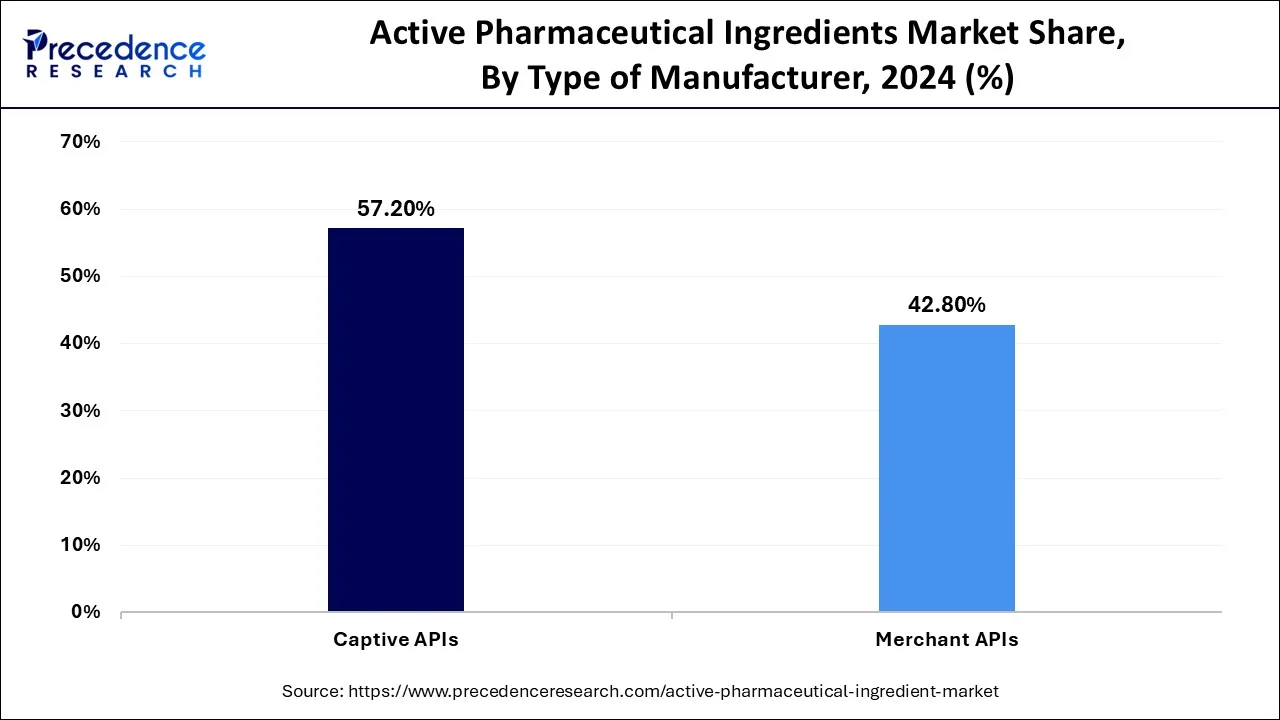
APIs find widespread application in CNS and neurology, oncology, orthopedic, cardiology, pulmonology, ophthalmology, gastroenterology, endocrinology and nephrology among others. In 20243, cardiology occupied major share of the market due to escalating commonness of target diseases internationally. As per the WHO, cardiovascular diseases may result in about 17.9 million deaths per year, worldwide, where 85.% of these deaths are instigated by heart attacks and strokes.
Cardiovascular Diseases
The cardiovascular diseases segment held the largest revenue share in the active pharmaceutical ingredients industry. This is due to the widespread use of numerous CVD medications brought on by the increasing occurrence of cardiovascular disorders. Cardiovascular diseases (CVDs) are the leading cause of mortality worldwide due to rising tobacco and alcohol consumption, bad eating habits, obesity, and physical inactivity. According to the European Society of Cardiology 2019 Statistics, there are currently more than 6 million new cases of cardiovascular diseases (CVD) in the EU and more than 11 million in all of Europe each year. With about 49 million sufferers in the EU, the disease has a significant economic cost of EUR 210 billion annually. Further, as per the WHO statistics, 17.9 million deaths worldwide in 2019 were attributable to CVDs, contributing to 32% of all global deaths. Heart attack and stroke deaths accounted for 85% of these fatalities. Also, in 2019, noncommunicable illnesses caused 17 million premature deaths (before the age of 70), and 38% of those fatalities were attributable to CVDs.
Cardiovascular drugs are essential for treating and preventing CVD. Cardiovascular drugs were the second most commonly used class of medication in the non-hospital sector in 2008, according to data from 84 of the countries included by the World Medicines Situation Report. Branded cardiovascular drug sales generated over US$40 billion in revenue in 2017 and are projected to reach US$90 billion by 2024. The WHO Anatomical Therapeutic Chemical (ATC) classification list5 and the British National Formulary (77/2019) both list 400 active pharmaceutical ingredients (APIs) or API combinations for the treatment or prevention of CVDs. The 2019 WHO Essential Medicines List (EML) contains thirty-two active pharmaceutical ingredients. As a result, the demand for active pharmaceutical ingredients has increased with the prevalence of cardiovascular disorders.
Oncology
The oncology segment is also expected to grow at the fastest CAGR during the forecast period. This is owing to the increasing prevalence of cancer and a larger percentage of people are anticipated to be affected by the disease in the years to come. The primary chemicals of chemotherapy for different forms of cancer are active pharmaceutical ingredients. Most of the market players are continuously developing and investing in new APIs to cater to the need in the oncology segment globally. For instance:
Key Companies & Market Share Insights
Pfizer is one of the foremost players in the global API marketplace. This prominent position of the corporation is majorly accredited to its comprehensive product offerings. The company has a robust brand imagethat offers it a competitive edge over other companies. To endure competitive position and reinforce its market position, the firmlargely focuses on implementing both organic and inorganic growth approaches including partnerships, agreements, collaborations, product endorsements, and acquisitions. In accordance with this, Pfizer acquired Anacor Pharmaceuticals, Inc. (US), a principal biopharmaceutical corporation developing small molecule therapeutics in June 2016.
Increasing numbers of players are subcontracting to curtail costs on employees, costly equipment, and infrastructure. However, there is sustained anxiety regarding the quality of these APIs manufactured abroad. Particularly, AstraZeneca Pharmaceuticals used to operate numerous manufacturing hubs in the U.S. Currently, only 15% of their APIs are generated in the U.S. and there are plans to end that small fraction and subcontract all manufacturing abroad.
By Type of Synthesis
By Type of Manufacturer
By Type
By Application
By Regional Outlook
For inquiries regarding discounts, bulk purchases, or customization requests, please contact us at sales@precedenceresearch.com
No cookie-cutter, only authentic analysis – take the 1st step to become a Precedence Research client
January 2025
April 2025
February 2025
September 2024